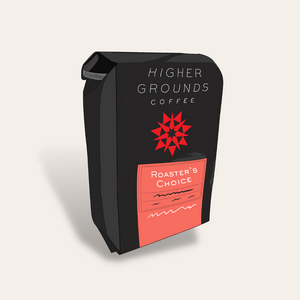It’s essential to use the right grind size when you brew coffee.
By controlling this key variable, you can perfect your brewing to get the right flavors in your cup, maximize repeatability and consistency, and give yourself the basis to experiment with recipes. This makes it beyond important to invest in a good coffee grinder. But there are plenty out there to choose from, and deciding which one to buy is more difficult than you might think. Read on to learn more about the various different types, and what you can expect from each.

Why get a coffee grinder?
Although preground coffee is widely available in supermarkets and from roasters, it’s much better to grind your beans right before brewing.
Coffee starts to degas as soon as it's roasted, and over time, it loses more and more of its volatile soluble flavor compounds. This is why freshness is such an important concept for coffee drinkers around the world.
However, by grinding your beans, you increase the surface area of the coffee dramatically. While beans sealed in a bag or container start to lose their flavors and aromas a few weeks after roasting, ground coffee loses its more subtle and complex tasting notes in just a matter of minutes. If left unused for too long, it will taste flat and stale in the cup.
It’s also important to use the right grind size for your particular brewing device and recipe. For instance, a French press typically requires a coarse grind; in contrast, the grind size for espresso should be very fine.
By grinding your coffee fresh, you can try it across a number of different brew methods and recipes, while also making sure it is as fresh as it can be every single day.

Blade grinders vs. burr grinders
There are two main types of coffee grinder: blade and burr.
Blade grinders
Blade grinders use metal blades to slice coffee beans into smaller particles. Typically, as you grind for a longer duration, the particles become finer.
However, while blade grinders are generally more affordable, they are also much less precise and consistent. As a result, you may end up with a mixture of bigger and smaller particles, meaning that your coffee ends up being under and overextracted at the same time.

Burr grinders
In contrast to blade grinders, burr grinders crush coffee between two ridged metal discs (or burrs) to grind it.
There are two main burr types: conical and flat. Conical burr grinders have two cone-shaped burrs, one large and one small. One burr rotates against the other to crush and grind coffee beans.

Flat burr grinders also use two burrs to grind coffee. However, as they are flat, rather than conical, the burrs lie on top of one another, meaning they are both parallel and concentric.
With both types, the user can adjust grind size by increasing or decreasing the distance between the two burrs. A larger gap equals a coarser grind, while a smaller gap makes the grind finer.

Hand grinders vs. electric coffee grinders
Another important thing to consider is whether you want an electric or a hand grinder.
Hand grinders
Hand grinders require a bit more effort to use, since you’re the one rotating the burrs. They also take much more time to grind than electric grinders do.
However, they are generally typically less expensive and more compact, making them a great option for people who want to brew coffee while travelling or are struggling for kitchen space.
The Hario Skerton Pro is a perfect example. It’s easy to use and has a stepped grind adjustment wheel that allows you to easily adjust the ceramic burrs to reach the desired grind size.

Electric grinders
Electric grinders start at a higher price point than hand grinders, and are usually bigger and bulkier than manual grinders. However, they grind coffee much more quickly and are incredibly convenient.
The Baratza Encore is a great entry-level burr grinder for people brewing coffee at home. Its straightforward controls make the grinding process simple and easy. Simply load the hopper with your favorite beans, set the desired grind size, and let the Encore do its work.
The Encore features a total of 40 individual grind settings, meaning you can play around with it to find the perfect grind size for different brewing methods.
However, a word of warning: be careful when you shop for electric grinders, and make sure you read the small print. Cheaper electric models are often blade grinders, which are much less precise.

Grinding is certainly a major part of the art of brewing coffee, and grind size plays a key role in getting the best from each bag of beans. However, choosing the right grinder is key, so think about your needs, your budget, and where you’ll be grinding coffee when making your decision.
But no matter what you choose, by grinding fresh every day, you’re already dramatically improving the flavors in your cup. If you haven’t got one already, then buy yourself a grinder – it’s an absolute must-have for anyone drinking coffee at home or brewing on the go.
Photo credits: Cris Flores, Baratza



